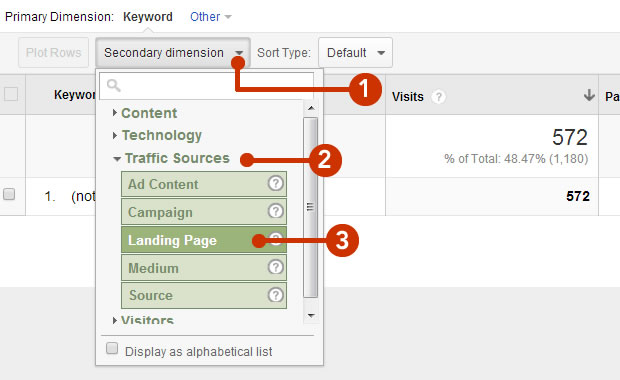Optimizing Search Engine Optimization with Secondary Dimension in Google Analytics
Optimizing Search Engine Optimization with Secondary Dimension in Google Analytics
Blog Article
Transform Your Analytics Approach With Secondary Measurement in Google Analytics
Checking out the capacity of secondary measurements in Google Analytics opens up a realm of opportunities for businesses looking for to raise their analytical strategy. By incorporating secondary dimensions right into information analysis, a new layer of insights emerges, dropping light on detailed individual behaviors and communications. This sophisticated degree of analysis not only refines marketing techniques but additionally deciphers hidden chances for optimization and growth. The tactical application of secondary measurements holds the essential to unlocking a treasure of very useful details that can revolutionize exactly how services act and translate upon their data.
Understanding Additional Dimensions in Google Analytics
Second measurements in Google Analytics offer added context to main information by permitting customers to evaluate metrics across a 2nd measurement, offering deeper insights right into individual actions and interactions on a website. Secondary Dimension in Google Analytics. While main measurements give fundamental data points such as pageviews, bounce price, and session period, secondary dimensions use an even more comprehensive view by segmenting the primary data additionally. This division permits customers to evaluate metrics in combination with an additional measurement, such as website traffic sources, demographics, or user habits
Benefits of Utilizing Additional Measurements
Using second measurements in Google Analytics supplies a tactical benefit by enhancing the deepness of evaluation and giving an extra extensive understanding of user interactions and habits on an internet site. By incorporating additional measurements, experts can get important understandings right into the performance of particular sections or variables within their data. This enables a more comprehensive examination of user actions past surface-level metrics, enabling a much deeper exploration of the elements influencing customer involvement and conversions.

How to Execute Second Dimensions
When incorporating secondary measurements in Google Analytics, one vital action is to pick the relevant metrics and dimensions to enhance the analysis procedure. Clicking on this switch will certainly open up a drop-down menu listing various dimensions that can be included to your main measurement for much deeper understandings.
After picking the appropriate secondary dimension, such as 'Source/Medium' or 'Gadget Group,' Google Analytics will display the data in a much more detailed format, enabling you to cross-analyze various aspects of individual actions. Bear in mind to try out various mixes of additional and key measurements to uncover beneficial patterns and patterns that can notify your advertising and marketing techniques. By applying secondary measurements attentively, you can gain a more detailed understanding of your internet site or application efficiency and make data-driven decisions to optimize your digital visibility.
Studying Information With Second Measurements
Enhance your data evaluation in Google Analytics by incorporating secondary measurements to dig deeper right into user actions patterns and maximize your digital advertising techniques successfully - Secondary Dimension in Google Analytics. By adding secondary dimensions to your primary information, you can obtain beneficial understandings that can assist you make notified choices concerning your site or application performance
Assessing data with second dimensions permits you to segment your key data better, supplying a more detailed sight of user communications. For example, integrating the key measurement of 'source/medium' with an additional measurement like 'landing page' can expose which particular web pages are driving traffic from different sources. This details can be important in improving your content technique or maximizing your advertising campaigns to boost conversions.
In addition, utilizing additional dimensions allows you to recognize correlations between different metrics, assisting you recognize the influence of various elements on individual actions. Whether it's evaluating demographics together with customer interaction metrics or tool classifications with conversion prices, secondary dimensions encourage you to reveal hidden fads and patterns that can assist redirected here your advertising initiatives.
Enhancing Efficiency With Additional Measurements
To enhance the efficiency of data analysis and decision-making in Google Analytics, incorporating secondary measurements is key to optimizing efficiency metrics and obtaining much deeper understandings right into customer behavior patterns. By using additional dimensions, experts can dig past surface-level data and uncover valuable connections that may or else go undetected. This optimization technique allows companies to tailor their marketing initiatives better, identify locations for improvement in web site functionality, and boost general customer experience.
Additional measurements provide an even more detailed view of individual communications by providing added context to main information metrics. Pairing the main measurement of 'landing web page' with an additional measurement like 'tool category' can disclose whether certain gadgets are more most likely to drive engagement on certain touchdown pages. This understanding can inform receptive design improvements or targeted marketing techniques to enhance performance.

Final Thought
Finally, the assimilation of additional dimensions in Google Analytics gives official website businesses with a powerful device to enhance their analytics method. Secondary Dimension in Google Analytics. By diving deeper into user behavior and interactions, marketing experts can reveal useful insights that can drive performance optimization and improve the total user experience. Leveraging secondary dimensions permits an extra extensive evaluation of data, causing even more educated decision-making and customized marketing efforts
Second dimensions in Google Analytics offer added context to primary information by permitting customers to evaluate metrics across a 2nd measurement, providing much deeper understandings into individual actions and communications on a site. While key measurements offer essential information factors such as pageviews, bounce rate, and session duration, second dimensions use an even more comprehensive sight by segmenting the primary information better.One of the essential advantages of using additional measurements is the capability to uncover connections and patterns that might not be right away obvious when analyzing data with main measurements alone.When incorporating second dimensions in Google Analytics, one crucial step is to choose the pertinent metrics and dimensions to improve the evaluation process. Matching the primary Web Site dimension of 'touchdown web page' with a secondary dimension like 'gadget group' can reveal whether particular tools are more likely to drive interaction on specific landing pages.
Report this page